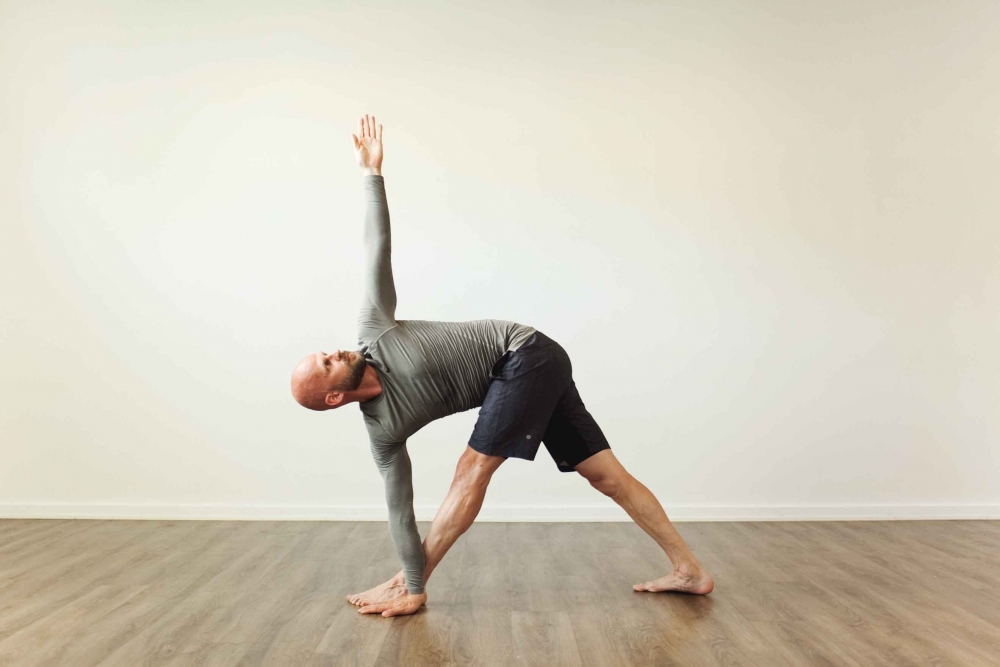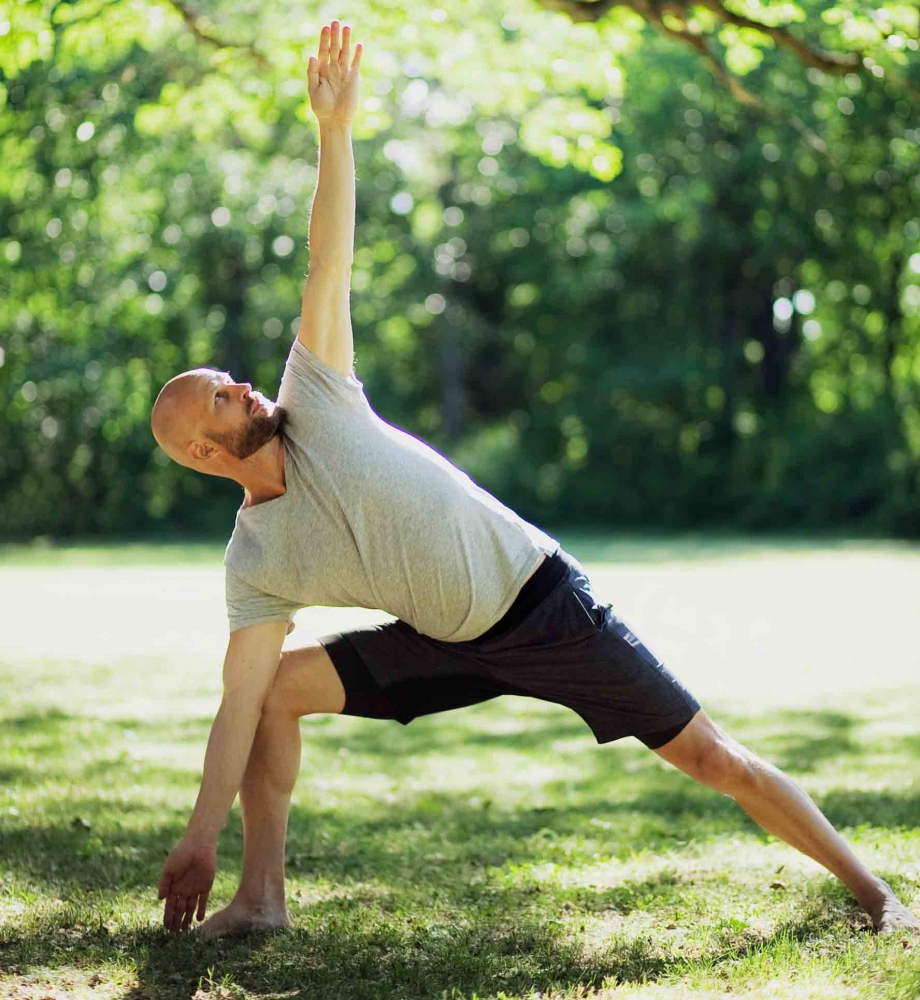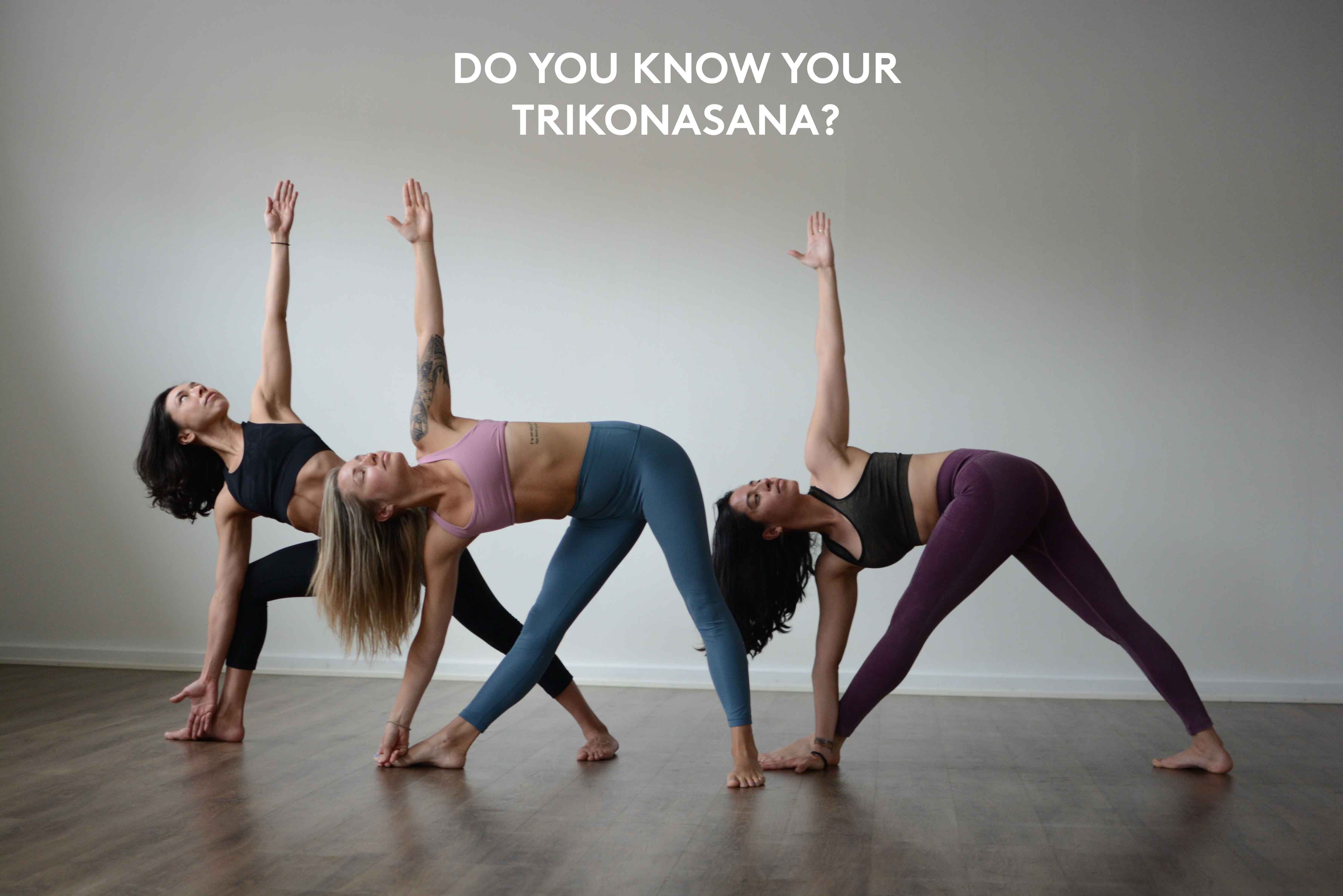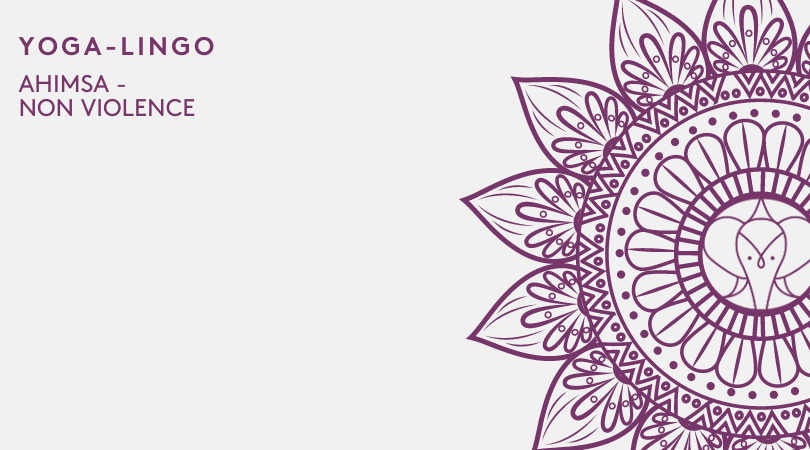Trikonasana and Variations of Triangle Pose
Extended - Revolved - Bound - Bikram
The name comes from the Sanskrit words utthita (उत्थित), "extended", trikona (त्रिकोण) "triangle" and asana (आसन) "posture" or "seat".
Trikonasana, or the Triangle pose, is a standing yoga pose that needs balance, flexibility, and strength. In Trikonasana, you are expected to extend your arms and spread your legs apart. Besides, you also turn one of your feet at a 90-degree angle. Now, you bend your upper body towards the foot in the front to allow one arm to reach forward as if you are touching the ground, while the other hand stretches towards the sky.
Depending on your school of yoga or yoga studio, there might or might not be a difference between trikonasana and utthita trikonasana. However, there is a variation between these two terms, especially in the torso’s position, and the hand placement. Trikonasana resembles parsvakonasana, but the difference is that trikonasana is performed with straight legs, while parsvakonasana the lead leg, is kept at a 90-degree angle.
When practicing Satyananda yoga, trikonasana has a sequence of asanas. These asanas are either four or five and are performed in a sequence. The triangle pose is many yoga teachers' favorite yoga pose, and they often have them in their yoga classes.
Utthita Trikonasana (Extended Triangle Pose)

Steps Utthita Trikanasana:
Begin this pose by standing in the Utthita Tadasana pose, and taking a few breaths.
Now, step your feet apart, around 4 or 5 feet, and ensure that your heels are in line with each other. Next, turn your left foot 90 degrees outwards.
Breathe in and push your torso outwards, and ensure that the left side of your torso is gradually bending at your hips.
Breathe out, bring your left arm towards the floor, and then place the arm behind your left foot. Breathe in, stretch your right hand up, and look at the raised hand as you breathe out.
Breathe in, and keep your body loose. Then, adjust your hips and feet to ensure that they are in the correct alignment, ensuring that your body is in a good and comfortable posture.
Breathe out as you go deeper into the pose. Hold this pose for around six breaths. Now, start breathing and extending your torso and arms deeper.
Breathe in, release your torso, and then come up and rest in Utthita Tadasana.
Repeat the process on the other side.
Parivrtta Trikonasana (Revolved Triangle Pose)

“Parivrtta,” is a Sanskrit word meaning revolve. Therefore, “Parivrtta Trikonasana,” means revolved triangle pose or the twisted triangle pose. This is a very powerful standing yoga pose, and it emphasizes balance, together with a deep twist of the spine. You need to give importance to alignment if you want to master the revolved triangle pose. Parivrtta Trikonasana has three components—side bend or twist, stretch, and balance.
Steps Parivrtta Trikonasana:
You start from the lunge pose
Now, slightly hop your back foot forward. Hinge the back heel down, and turn the foot 60 degrees inwards.
Lineup your middle back arch with your front heel
Straighten your front leg
Square your hips to the top of your mat. Your right hip should face backward and your left hip forward.
Now, lift your left hip, so your hips are parallel to the floor.
While keeping your hips and head centered, place your left fingertips or palm on the floor. This should be just outside of your right foot.
Press down your right foot's inner edge, and move back your right hip. Hold your right hip using your right hand—this helps you to empower this deed. Ensure that your right thumb is across the crease of your hip and the fingers are on the outer hip. Using the hand, pull and spread your right hip backward.
Turn your abdomen upwards, and rotate your right shoulder over your left shoulder.
Now, extend your right hand upwards—your arm should be in a vertical position to the floor
Point your biceps towards the mat’s top
Look up, hold the posture and then breathe
To release, face down, and place your hand on any side of your front foot. Next, bend the knee of your front foot, step your back foot backward, and then lift your back heel.
Repeat this posture on the other side.

Baddha Trikonasana (Bound Triangle Pose)

The bound triangle pose is a variation of Trikonasana, as yogis extend their torsos beyond to allow them to take their hands around for binding. The main elements of mastering baddha trikonasana are the contractions of your abdominal muscles and the stretch of the hamstring of the extended leg. Bound yoga poses assist in improving the flexibility of the hips and arms. In addition, they help in stretching the muscles of the diaphragm and the activation of internal organs.
Steps baddha trikonasana:
Start from lunge pose
Hinge the back heel downwards and turn your foot 30 degrees inwards.
Now, place both hands on the floor—inside your front foot.
Breathe in fully. Breathe out, and fold your torse inside your front thigh.
Using your right hand, hold your right calf’s back.
Bring your right shoulder beneath your right thigh, and the top of your shoulder to the back of the calf.
Place your right hand’s back in the outer part of your right hip
Swing up your left arm, and hold the left wrist behind your torso using your right hand.
Rotate your left shoulder over your right shoulder. Face down.
Straighten your right leg.
Lift your torso to be in a parallel position with the floor—press your knee into your hand and your hand into the knee so that your knee and torso isometrically move in reverse directions.
Turn your ribs and abdomen up. Face up, hold the posture and breathe.
To release, face down. Bend your front knee. Release the bind and place your hand on any side of your foot
Repeat on the other side.
Parivrtta Baddha Trikonasana (Bound Revolved Triangle Pose)

Steps Parivrtta Baddha Trikonasana:
- Begin from the lunge pose. Hold your upper thigh with your right hand—your thumb should be on the middle of your thigh, and the fingers on your outer quads.
- Breathe in and lift your torso and your left hand vertically.
- Now, breathe out, twist your torso to the right and then place your left shoulder on your outer-right knee.
- Bring your right hand to your right hip’s crease. Now, pull your right hip backward and down.
- Now, swing your left hand underneath your right thigh and your right hand behind your back. Hold your right wrist using your left arm or vice versa.
- While facing downwards, slightly step your back foot forward. Hinge your back heel down, and then turn the foot 60 degrees.
- Move your right hip backward until your thigh is parallel to your mat’s long edge.
- Make your front leg straight.
- Turn your ribs and abdomen up, and rotate your right shoulder over your left shoulder.
- Face up. Hold the pose and then breathe.
- To release, look downwards, bend your front knee and free your hands to any side of your right foot. Step your right foot backward and then lift your back heel.
- Repeat the same steps on the other side.
Bikram's Triangle (Trikanasana)

The Bikram triangle pose requires open and strong hips. At first, the pose can be extraordinarily challenging, particularly as you continue building strength in your lower body. The intensity in your legs and hips can easily overwhelm you, but you need to concentrate on the connection of your straight leg and spine. You can achieve a straight line, even when your knees are not bent so deeply. In addition, ensure that your abdomen is straight and firm as possible. Then, make sure that your hips are open and not twisted.
This posture helps in building strength in your hips and stretching them. In addition, it stretches your chest and strengthens your legs. Lastly, it helps in boosting your focus and confidence.
Steps Bikrams Triangle Pose:
Start in while you are still, and stand with your hands by your sides and feet together
As you breathe in, stretch your arms overhead
As you breathe out, take a step to your right side—probably 2-3 feet. Ensure that your hands are parallel to the ground—sideways.
Now, turn your right foot outwards, and ensure that your hips facing forward as much as possible.
Bend your right knee 90 degrees— your knee should be directly over your ankle. Your upper body should remain straight, and your left hip as back as possible. Now, turn your palms to face forward.
Bring down your upper body. Your right hand should brush your right big toe, and your left arm should be straight up. Your chin should be facing your left shoulder. Now face upwards, hold the pose and count to 10.
Turn your head forward, and bring your torso upright. Ensure that your hands are in a parallel position with the ground—sideways.
Straighten your right leg, and turn your toes to face forward.
Turn your left foot outward, and ensure that your hips face forward.
Bend your left knee 90 degrees—the knee should be directly over your ankle. Your upper body should remain upright, and your right hip back. Now, turn your palms to face forward.
Bring down your upper body. Your right hand should brush your left big toe, and your left arm should be straight toward the ceiling. Your chin should be facing the right shoulder. Now, face upwards, hold the pose, and count to 10.
Turn your head forward, and bring your torso upright. Ensure that your arms are in a parallel position with the ground—sideways. Straighten your left leg and turn your toes to face forward.
As you breathe in, bring your feet together, and stretch your hands overhead.
Breathe out and lower your hands to the side. Remain still.
The benefits of Triangle Pose
- It expands your side waist – many people usually neglect their side waist. However, practicing the triangle pose helps open the sides of your waist. A tight waist side usually causes alignment problems like discomfort and pain. However, practicing trikonasana gives your waist a deep side stretch, which helps open and expands it.
- Helps in opening the hips – the forward and backward bend yoga poses are very effective in opening up the hip and glutes flexors. However, many yogis have forgotten entirely about the side muscles in their bodies, including the hips. The muscles in the side hip usually tighten as you walk, run or cycle. Moreover, that's why trikonasana is very important for people who use their lower body in their daily activities. Practicing the triangle pose assists in opening up the side hips.
- Assists in external rotation of your legs – the external rotation of the legs is essential, and you can master it by practicing the triangle pose regularly. Many people usually stand with their legs when they are rotated internally, and that’s the reason why external rotation is essential. It helps strengthen the pelvis and legs and develop balance in your lower body. Practicing trikonasana can be an added advantage to yogis, as it teaches them external leg rotation. This, in turn, prepares the yogis for the most advanced yoga poses.
- It opens the heart – one of the most adorable and desirable health benefits of practicing trikonasana is a mild heart-opening yoga posture. You will rotate your chest upward when you practice the posture with the proper alignment. This, in turn, creates an arch in your back, which slightly opens up your upper body and the heart.
- Strengthens your core muscles – when you practice trikonasana with accuracy, you shall benefit your core muscles. The triangle pose encourages yogis to use their back and abdominal muscles to create balance. This, in turn, assists the body in developing stamina and strength in the body’s core muscles.
- Lengthens your back – some of the activities in your daily life make your back to become weak. However, practicing the triangle pose helps stretch your back muscles, thus making them stronger. As a result, trikonasana saves from the adverse effects of backache and arthritis.
- Assists in healing your internal organs – since trikonasana involves twisting your body, this helps massage your internal organs. This, in turn, helps them to remove any toxins inside them. Additionally, the practice of trikonasana sets the organs for optimal functioning, which ensures total health for your body.
Traditions
Almost all traditions in yoga have Trikonasana in their toolbox. If it is ashtanga, hatha yoga, Bikram, online yoga, Iyengar, or any vinyasa class, you would most likely hear the yoga instructor calling out this beautiful yoga posture during class. It can be very challenging and is often called the master pose because it simultaneously works so many body parts.
Pose type
Standing posture. Twists
Preparatory poses
Sun Salutations, Warrior I, Warrior II, Warrior II
Beginner tips
- If you have tight hamstrings, a block can come in handy to place your hand on
- No block in sight. Place hand on the chin for support
- Avoid and prevent hyperextension in the knee by mico bending it
- In Bikram's triangle, if you don't have the strength to have the front leg parallel to the floor, place your elbow directly on the knee instead of straightening it.
Triangle Pose Variations
- Utthita trikonasana (extended triangle pose)
- Trikonasana (Bikram's triangle pose)
- Baddha trikonasana (bound triangle pose)
- Baddha parivritta trikonasana (bound revolved triangle pose)
- Parivritta trikonasana (revolved triangle pose)
- Supta trikonasana (reclining triangle pose)
- Supta parivrtta trikonasana
- Supta utthita trikonasana










